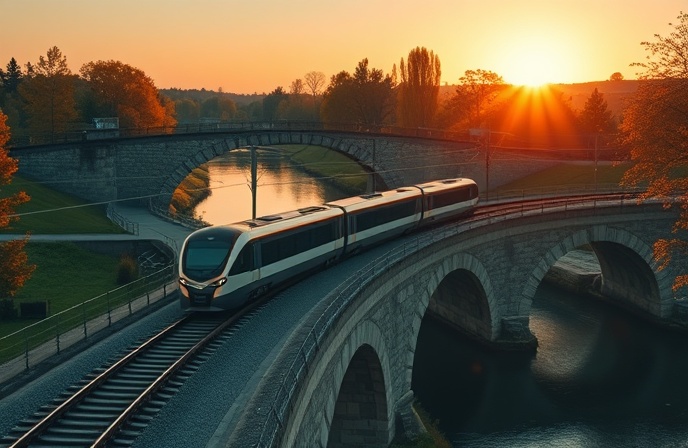HIMA Güvenlik Kontrolörleri: Türkiye Demiryolu Güvenliğinin Geleceği
Demiryollarındaki güvenliği optimize etmek için HIMA güvenlik kontrolörlerine mi ihtiyacınız var? Gerçek zamanlı veri analizi ve otomasyonla kazalara karşı önlem alın! Keşfedin nasıl!

“`html
Optimizing Railway Safety Protocols: The Crucial Role of HIMA Safety Controllers
This article delves into the critical aspects of enhancing railway safety protocols, focusing on the pivotal role of advanced safety systems, particularly HIMA safety controllers. Modern railway networks are intricate systems demanding sophisticated safety mechanisms to mitigate risks and ensure reliable operations. This discussion examines the challenges inherent in contemporary rail operations, highlighting the need for robust and adaptable safety solutions. It explores the evolution of safety technologies, including the development and integration of HIMA safety controllers, which are revolutionizing railway safety practices. This examination is crucial for understanding the future trajectory of railway safety and the continuous improvement of passenger and freight transport systems.
The Evolving Landscape of Railway Safety
Railway safety is a multifaceted discipline, encompassing a broad spectrum of factors, from track maintenance and signaling systems to crew training and emergency response protocols. The scale and complexity of modern rail networks necessitate a proactive, data-driven approach to safety management. Historically, manual processes and limited automation have contributed to safety risks in some sectors. However, recent technological advancements, particularly in digital communication and automation, are fundamentally reshaping the safety paradigm. This includes real-time data analysis, predictive maintenance, and the implementation of more sophisticated safety-critical systems, fostering a shift towards proactive risk mitigation.
The Importance of Real-Time Data and Automation in Preventing Accidents
Real-time data collection and analysis are paramount in railway operations. Advanced sensors, trackside monitoring systems, and onboard diagnostics provide a constant stream of information about the state of the infrastructure and rolling stock. This data enables proactive interventions, predictive maintenance, and rapid responses to anomalies. Implementing automation, from onboard driver assistance systems to centralized control centers for monitoring and coordination, streamlines operations, minimizes human error, and ensures swift reaction times to potential incidents. Sophisticated algorithms analyzing real-time data can anticipate and mitigate risks before they escalate into serious accidents. This data-driven approach, integrated with advanced automation systems, represents a significant leap towards higher safety standards and more efficient operations in the railway industry.
HIMA Safety Controllers: The Vanguard of Modern Railway Safety
HIMA safety controllers, a new generation of safety-critical systems, are increasingly crucial in managing railway operations. These controllers play a central role in maintaining safe track access and operations across diverse railway environments. Their functionality includes regulating train speed and movement based on real-time signal status, actively controlling train speed and separation distances in relation to other trains on the same track, and ensuring clear communication and coordinated movements to prevent collisions and derailments. This advanced technology enhances precision and reliability, significantly minimizing accident risks and contributing to the overall safety and reliability of railway operations. Furthermore, HIMA controllers seamlessly integrate with other safety systems, creating a comprehensive and integrated approach to enhancing railway safety protocols.
Conclusion: The Future of Railway Safety and the Role of HIMA Safety Controllers
The railway industry faces an evolving landscape of safety challenges, requiring a comprehensive and proactive approach. Modern rail networks demand the integration of advanced technologies to mitigate risks and ensure reliable operations. Real-time data analysis, predictive maintenance, and automation are crucial in minimizing accident potential, reducing operational delays, and enhancing passenger and freight transport safety. HIMA safety controllers are at the forefront of this technological revolution, enabling a higher degree of precision, reliability, and safety. By leveraging advanced technology and data-driven decision-making, the railway industry can continuously improve safety standards and create a more secure and efficient transportation system for the future.
The proactive implementation of advanced safety technologies, such as HIMA safety controllers, is essential for balancing increased operational efficiency with the paramount importance of absolute passenger safety. By employing real-time data analysis, predictive maintenance models, and advanced automation tools, the railway industry can navigate the complexities of modern operations while ensuring passenger and freight safety. This strategy emphasizes continuous improvement and adaptability to emerging technologies and operational challenges. Adopting a holistic and proactive approach to safety will characterize the future of railway operations, leading to higher safety levels and increased efficiency. This focus on data-driven methodologies, coupled with integrated automated systems, paves the way for a more predictable and resilient railway network.
The advancements in HIMA safety controllers are not simply about accident avoidance; they are about fostering a more reliable and efficient railway system. Promoting a culture of continuous safety improvement and adopting technologies like HIMA safety controllers enable railway systems to manage complexities and enhance safety measures. This translates into reduced operational costs and increased confidence among passengers and freight operators. The benefits extend beyond enhanced safety, incorporating improved operational efficiency and reduced costs. Investing in proactive safety measures is an investment in the long-term sustainability and prosperity of the railway industry.
“`


